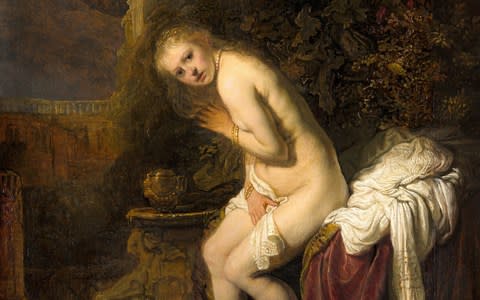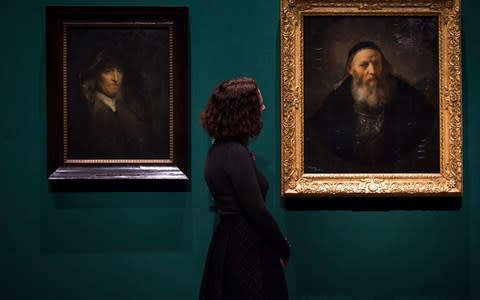Secret ingredient helps explain how Rembrandt's paintings got their layers

Scientists say the discovery of a missing ingredient in Rembrandt's paints helps explain how the Dutch Master achieved the distinctive layered effect in many of his paintings.
For years, it was believed the painters used ingredients typically available to his 17th-century peers - lead white pigment, cerussite and linseed oil.
However, researchers who used cutting-edge x-ray technology to analyse samples taken from three of his masterpieces were surprised to discover a mineral found more commonly nowadays in car paint.
The team of French and Dutch scientists discovered plumbonacite in the artist's paint after analysing tiny samples taken from three of Rembrandt's masterpieces - the Portrait of Marten Soolmans at Rijksmuseum, Bathsheba from The Louvre in Paris and Susanna housed at Mauritshuis in The Hague.
After removing the samples, which measured less than 0.1mm, the team then applied them to state of the art imaging techniques at the European Synchrotron, Grenoble, France (ESRF).
The minuscule scrapings were subjected to high-powered x-rays which revealed the chemical composition of the paint used for each different layer.

Plumbonacrite was found in the thick impasto layers of the paintings but not in the base coat of paint.
Dr Victor Gonzalez, of the Rembrandt Rijksmuseum, Amsterdam, and Delft University of Technology, expressed the group's surprise at discovering the presence of the crystalline substance.
"We didn't expect to find this phase at all, as it is so unusual in Old Masters paintings. What's more, our research shows its presence is not accidental or due to contamination, but the result of an intended synthesis," he said.
Until now, plumbonacrite had been found only in paintings from the 20th century and one earlier painting - Haystack under a Rainy Sky painted by Vincent Van Gogh painted in 1890, 230 years after Rembrandt died.
It is today used in the car manufacturing industry as a colour preserver for red and orange paint while modern painters often mix a synthetic version into white paint to give it a pearlescent effect.
The authors of the paper, published in the journal Angewandte Chemie, speculate that plumbonacrite found its way into Rembrandt's paint through his use of lead oxide, or litharge, to thicken up his paints.

The practice of layering oil paint thickly onto paintings to give them texture and add brilliance to highlights and depth to shadows had originally been mastered by Titian.
But Rembrandt took the technique on, using it to accentuate the detail on the jewelry and robes of his subjects as well as bring a life-life quality to their skin.
Dr Marine Cotte, an internationally renowned art conservation expert at the ESRF, explained: "The presence of plumbonacrite is indicative of an alkaline medium. Based on historical texts, we believe that Rembrandt added lead oxide, or litharge, to the oil in this purpose, turning the mixture into a paste-like paint."
Alkalid paints are quick-drying, lending themselves to building a layered effect on a canvas.
The researches say their discovery will now shape how Rembrandt's paintings are restored and conserved.
However, Dr Annelies van Loon, of the Rijksmuseum said that the test is too narrow to prove conclusively the composition of all of Rembrandt's paints, adding that the team now plan to run similar tests on paintings by other 17th-century Dutch masters.
"We are working with the hypothesis that Rembrandt might have used other recipes, and that is the reason why we will be studying samples from other paintings by Rembrandt and other 17th Dutch Masters, including Vermeer, Hals, and painters belonging to Rembrandt's circle," she said.
